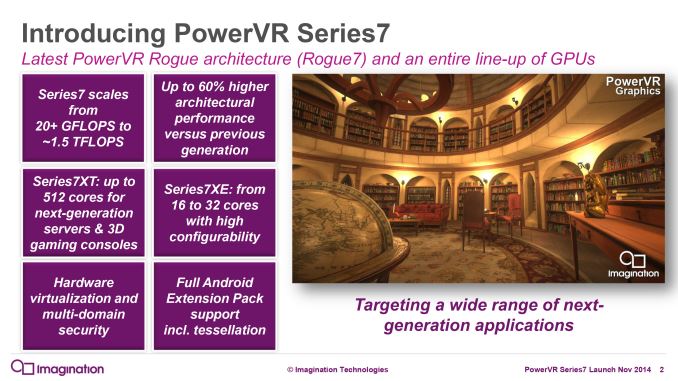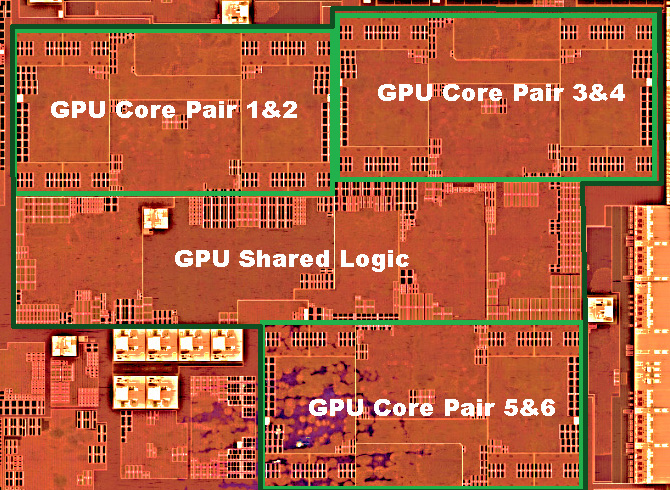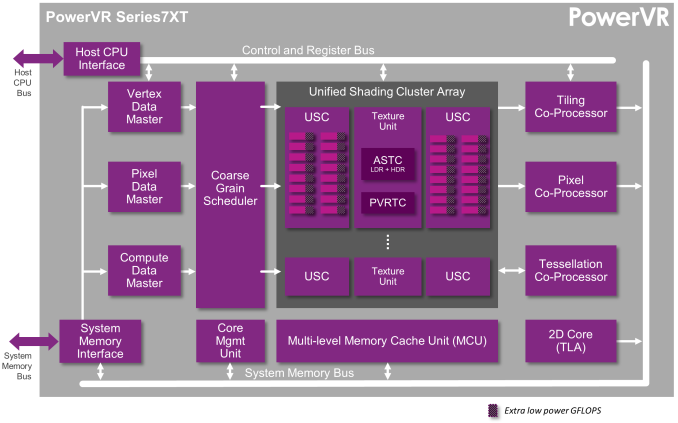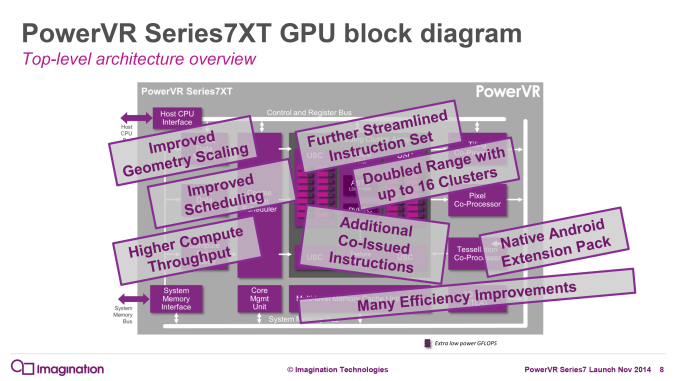The Apple iPhone 6s and iPhone 6s Plus Review
by Ryan Smith & Joshua Ho on November 2, 2015 8:00 AM EST- Posted in
- Smartphones
- Apple
- Mobile
- SoCs
- iPhone 6s
- iPhone 6s Plus
A9's GPU: Imagination PowerVR GT7600
With so much time spent talking about A9 from the perspective of its manufacturing process and its Twister CPU, it’s all too easy to forget that Apple has been working on far more under the hood than just CPU performance. As has been the case for generations now, Apple continues to focus on GPU performance, laying the groundwork for significant performance improvements with every generation.
Going all the way back to the first iPhone and its Samsung-developed SoC, Apple has been a patron of Imagination Technologies and their PowerVR GPUs. This has been a productive relationship for both parties, and for A9 this hasn’t changed. To no surprise then, the GPU in the A9 is another design in Imagination’s PowerVR Rogue family, the GT7600.
Briefly, while Apple continues to not disclose the GPU used in their designs – referring to the A9’s GPU as iOS GPU Family 3 v1 – a look at the iOS Developer Library makes it clear what GPU family is being used. Apple still uses tile-based deferred rendering GPUs (to which only PowerVR fits the description), so the only real questions are which family is in use and how many cores are present.
With A8 and its GX6450, there was a pretty clear smoking gun to identify the GPU family via the inclusion of ASTC support, a feature only available on Series 6XT and newer GPUs. There aren’t any such smoking guns on the A9, but the Metal Feature tables indicate that there are a handful of new low-level features which are indicative of a newer revision of the PowerVR Rogue architecture. Coupled with the fact that Imagination announced PowerVR Series 7 nearly a year ago and Apple has proven to be able to implement a new PowerVR design in under a year, and it’s a safe bet that A9 is using a Series 7 design.
As for the configuration, the A9 die shot quickly answers that one. There are 6 distinct GPU cores on the A9 die, divided up into 3 pairs with a shared texture unit in between them. So it may have taken Apple a generation longer than I initially expected, but with A9 we’re finally looking at a 6 core GPU design for the iPhone.
From a feature and design standpoint then, the GT7600 is not a significant departure from the GPUs in the A8 and A7 SoCs, however it does have some notable improvements along with some optimizations to boost performance across the board. Notably, relative to the GX6450 it features a geometry tessellation co-processor as a base feature, a function that was merely optional on Series6XT and, at least in Apple’s case not used. Unfortunately, looking through Apple’s developer documentation it does not appear that tessellation support has been added for Metal, so assuming for the moment that Apple hasn’t stripped this hardware out, they definitely don’t have API support for it.
Otherwise the bulk of Imagination’s focus has been on small tweaks to improve the Rogue architecture’s overall efficiency. Among these, the Special Function Units can now natively handle FP16 operations, saving power versus the all-FP32 SFUs of Series6XT. SFU operations can now also be co-issued with ALU operations, which improves performance when SFUs are being issued (which in Imagination’s experience, has been more than expected). Finally, the Vertex Data Master (geometry frontend), Compute Data Master (compute frontend), and the Coarse Grain Scheduler have all been updated to improve their throughput, and in the case of the scheduler improving its ability to keep USCs from stalling on tile-interdependencies.
Looking at the broader picture, after initially being surprised that Apple didn’t jump to a 6 core design with A8, with A9 it makes a lot of sense why they’d do it now. GPUs have and continue to be the biggest consumers of memory bandwidth in high-performance SoCs, to the point where Apple has outfit all of their tablet-class SoCs with a wider 128-bit memory bus in order to feed those larger GPUs. Conversely, a 64-bit memory bus with LPDDR3 has always represented a memory bandwidth limit that would bottleneck a more aggressive GPU design. With the move to LPDDR4 however, Apple has doubled their memory bandwidth, and coupled with the larger L3 cache means that they now have the means to effectively feed a larger 6 core GPU.
Overall then, between the 50% increase in the number of GPU cores, Imagination’s architectural efficiency improvements, Apple’s own implementation optimizations, and what I don’t doubt to be at least a decent increase in the clockspeed of the GPU, Apple is promoting that A9 should see an incredible 90% increase in GPU performance relative to A8. And as we’ll see in our performance benchmarks, they are more than capable of delivering on that promise.
| Mobile SoC GPU Comparison | ||||||||
| PowerVR SGX 543MP3 | PowerVR G6430 | PowerVR GX6450 | PowerVR GT7600 | |||||
| Used In | iPhone 5 | iPhone 5s | iPhone 6 | iPhone 6s | ||||
| SIMD Name | USSE2 | USC | USC | USC | ||||
| # of SIMDs | 12 | 4 | 4 | 6 | ||||
| MADs per SIMD | 4 | 32 | 32 | 32 | ||||
| Total MADs | 48 | 128 | 128 | 192 | ||||
| Theoretical GFLOPS @ 300MHz |
28.8 GFLOPS | 76.8 GFLOPS | 76.8 GFLOPS | 115.2 GFLOPS | ||||
| Pixels/Clock | N/A | 8 | 8 | 12 | ||||
| Texels/Clock | N/A | 8 | 8 | 12 | ||||














531 Comments
View All Comments
nerd1 - Saturday, November 7, 2015 - link
720p screen in 2015, worse battery life, no sd slot, no wiress charging, terrible camera and still THE BEST phone huh?It has best performing processor, no one argues that, but I still wont touch it with a stick.
JaytB1 - Sunday, November 8, 2015 - link
I use iPhone mainly because of the better security/privacy, no carrier/manufacturer delay/total dismissal of security/OS updates, earlier/exclusive/better releases of triple A games/apps and uncluttered interface. I agree with the gold award, the iPhone 6s (plus) is the first phone in a while that made me see that there are still possibilities to innovate in the smartphone space.I've seen Android users avidly defending their high PPI's, megapixels, core counts. Oh, but it's customizable and I can put a ton of widgets on my homescreens. There's only a small minority of tech obsessed people who care (proof is in the huge low/medium end market share, indicating the amount who don't care for specs but just want a working phone). For me, all I want is to launch an app, not stare at my home screen. In the past, Android users where more often than not boasting about benchmarks and how their hardware was superior. Now that the tables are turned, hardware all of a sudden doesn't matter as much anymore or the tests must be rigged by a biased Anandtech (who has nothing to gain and everything to loose if they were posting nonsense).
I've seen Samsung and other manufactures add so many gimmicks to their phones, many of which are plain impractical (try doing 'airview' while jogging and you'll get the picture).
I admit that fast charging would be nice but, for me, completely unnecessary (it's not like an iPhone charges slow in the first place).
Then there's wireless charging, you do realize that you still have to plug in the charge pad with a cable right? So the only difference is that you don't need to plug that cable into your phone, but you'll need more power to fill your device up as compared to using a cable (more waste power) and a permanent spot for your charging pad. Again, for me I don't really see the appeal for that either.
We could also talk about PPI but to keep it brief, I'd rather have a device perform well with individual pixels I can't distinguish, than a screen that would impact performance with pixels I still can't see... But more of them.
I could go on about how a blind photo evaluation test on a respected Android site had Android users voting the iPhone 6s as having the best overall picture quality, but now that the iPhone scored a tiny bit lower than some Android phones in one test, it suddenly has a 'far inferior' camera. Then there's the RAM, curved screens and so many other things I could mention, but my point is that I think Android users can't recognize a genuine game-changing feature-list because they're so used to getting bombarded by tons of arguably useless high spec lists and gimmicks that are marketed as 'the next big thing'.
It's almost as if Google took over the reality distortion field from Apple. Just wait a couple of years when all Android devices have 'Android sense' (or something) displays (3D touch), THEN it will be a game changing feature because they'll have 1000's of pressure levels they can sense as compared to the 'useless' iPhone's (hypothetical) 128 levels.
Don't get me wrong here, I'm not trying to bash Android or people who choose to use it, I just don't like those who post nonsense without anything to back it up just so they can sleep at night having convinced themselves that they bought the right phone. I've been a reader of this site for years and believe their test results to be correct, as they've always been. People who claim otherwise should come with facts or stop sprouting nonsense.
I, for one, agree with the review and think it's the phone with the best all round feature set on the market today. Is it perfect? Of course not, but it's a genuinely forward thinking and exceptional smartphone in a stale smartphone market, and that deserves that gold award in my book.
Thanks for the review!
Aritra Ghatak - Sunday, November 8, 2015 - link
As the reviewers pointed various aberration and distortions associated with using a brighter lens and that it is wise Apple went with the F 1/2.2 aperture lens. Could you please explain how Samsung manages with an F 1/1.9 aperture lens in Galaxy S6? Or for that matter the F 1/1.8 lens in LG G4 or Nokia Lumia 720/730?patamat - Sunday, November 8, 2015 - link
Well, we all know who Anand went to work for after writing few "balanced" reviews like this one.(apple ...)
Psymac - Monday, November 9, 2015 - link
Where is the phone function analysis of this iPhone?zimmybz - Tuesday, November 10, 2015 - link
I guess I'll try to build the bridge for the Droid guys here that are having a hard time.I haven't had an iPhone since the Galaxy S came out. Been a droid user since.
I recently got a 6S Plus. I sold a Note 5 and cancelled a pre-order for a Nexus 6P.
I will say it since nobody else will. The Note 5 has a great camera, S-Pen is cool, and enough RAM to keep multi-tasking running, but otherwise it's a shitty phone. The battery life and Touchwiz still leave a LOT to be desired. Build quality is great, but it suffers from what every other Droid phone suffers from - fractured, fragmented hardware eco-system and specs driven production. (Hang on)
If you need to know why you should cancel a 6P pre-order, look at the subreddit (Holy crap, lol.)
Anyways, in my first week with the 6S Plus, I hit 22% battery with 88 hours standy and 13 hours usage. That is completely insane.
Back to the Note 5 - look at the graphs on the review here. This phone absolutely DOMINATES the Note 5 across the board, a fact which I can confirm first hand.
I can also tell you that holding the phones side by side looking at the same picture taken on the Note 5, the displays are functionally indistinguishable from the other. (So much for all that resolution, I guess)
This is a large reason why the Note stutters against the 6S Plus. It's pushing a LOT of pixels that aren't really evident in day to day use, especially sitting next to the iPhone.
I guess I finally reached the point, I just want the best phone every year regardless of manufacturer or software.
Until Google makes it's own hardware in house and breaks free of QualComm, Apple is going to beat them every year going forward. I'm not 20 anymore, I don't care about a home screen widget. I want the battery not to drain from some stupid Google Play Services memory drain while the phone is sitting on my desk.
I don't want Samsung Services blowing up the battery either. And - NO - I should not have to root kit, Package Disable, Power Saver, Turn off Location, etc, etc, etc. I paid $1000 for a premium handset with lots of features.
Oddly enough, the iPhone can leave all that crap on and STILL get good battery life. The arguments for Android are shrinking right now. I'll never buy another Samsung phone again. I will miss the S-Pen, but Touchwiz is heinous, even in it's current iteration.
I would really love to see Google put up a fight in the premium handset market, but I don't think their hearts are in the hardware QUITE yet.
Anyways, happy 6S Plus user here, 4+ year droid convert at the moment. We'll see what next year brings.
zeeBomb - Wednesday, November 11, 2015 - link
Ss or bs (sorry I just had to)JTRCK - Friday, November 13, 2015 - link
I actually returned a 6S Plus for the Nexus 6P and the main reason was PRICE. They are as equally performant in day to day tasks, but the Nexus 6P had better multitasking performance for me due to the buttons and added power of a side launcher which is not possible on iPhone. I basically never have to go to the home screen again when using Google docs, searching the web, etc... I tried both out for about a week. The only feature I liked on the iPhone 6S Plus better was the cooler white colors of the LCD; other than that the Nexus 6P was better "for me" in every aspect. The phone "flies" in every sense of the word. No stutters, no lag, no unresponsiveness (typical of Samsungs). I have been an iPhone user since the 3GS. I also used the iPhone 6 Plus this year for 5 months.And I truthfully don't understand all this commotion over the new iPhone 6S Plus being the best phone ever released. Outside of "3D touch," there is not much difference in day to day performance or general use between both this year's model and last year's model. That is generally a great testament to iOS stability and performance. So much so that my old iPhone 4s opened apps faster, surfed faster, multitasked faster, etc, than my now defunct Note 4. Apple has been on top of their game for years, IDK why android fans have only now noticed. But iOS is truly very limited. You will sooner or later find out the gates keep you truly locked in.
But the main factor for me, again, was price. I do not in any way find the iPhone to be a better phone than the Nexus 6P. In fact, I find its system to be inferior in a multitude of ways. Is the iPhone Better than the Note 5 and all its clumsy and useless features? Yes. But the Nexus 6P is in a category all its own. Especially for $650. That is exactly what I paid for the 128GB model compared to the $1,170 I paid for the iPhone 6S Plus.
astroboy888 - Wednesday, November 11, 2015 - link
"FinFET transistors are necessary because as transistors get smaller their leakage (wasted power) goes up, and without FinFETs leakage would spiral out of control. In fact that’s exactly what happened on the 20nm nodes from Samsung and TSMC; both companies thought the leakage of planar transistors could be adequately controlled at 20nm, only for leakage to be a bigger problem than they expected"It is not they "discovered" 20nm leakage was high; therefore they switched to 16nm FinFet. This is an incorrect comment.
FinFet transistors structure had been on the road map and in development at TSMC for more than 10 years. TSMC's first finfet transistor was demonstrated in 2002 when the inventor Professor Chen-Ming Hu of UC Berkeley was working at TSMC as CTO. Therefore Finfet process had always been on the roadmap for 16nm process. The 20nm planar process had always been on the road map as a planar process. Every process node takes about 3-5 years to develop, so the customers (semiconductor chip designers) signs up 3-5 years before hand to co-work with TSMC to design a chip for that process. These were communicated ahead of time and contracts where signed.
In the late 1990s and early 2000s, the semiconductor industry was pushing for SOI (Silicon On Insulator such as GaAs "Gallium Arsenide), which completely eliminates leakage current. But the transistor performance turned out to be too unpredictable and too expensive to manufacture. Therefor the industry stuck with silicon, until FinFet structure was invented in 2000 and manufacturing process perfected some 10 years later.
gonsolo - Thursday, November 12, 2015 - link
If I may suggest something: I'd like to see app startup times as a benchmark from iPhone 5 onwards. This is something I'm doing a lot; waiting for apps to start.